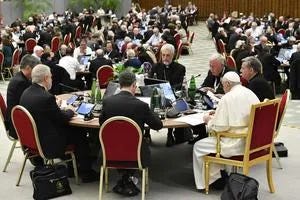The Seinfeld Synod
A Vatican council about nothing
I’ve noticed that the Catholic world seemed to have lost interest in the Synod on Synodality about the time the first images of the meetings appeared online.
Micheal Matt of Remnant Newspaper was in Rome for the duration, as was LifeSiteNews.com’s John Henry Westin. They produced daily commentary on the meetings for the first week, but the close, both men had pretty much moved on to other things. Brilliant reporter Diane Motagna found some news, but always outside the Synod itself. And she had to work hard to find any story worth the pixels.
My attention, too, waned. The images of mostly old people sitting around large round tables in a hideous modernist cavern to “listen” looked and sounded like Dullsville on sleeping pills. The "watching paint dry” analogy fails to capture the sheer maddening boredom of the affair because one watches paint dry in anticipation of a better future, like being able to apply a second coat. Everyone knew that this “Synod about nothing” would lead only to more nothingness.
Why would they waste all this money and effort?
Nostalgia.
Bergoglio is a nostalgia freak, though he would never admit it. He is nostalgic, not for centuries when the Catholic Church served as the world’s conscience, but for that period from 1965 to about 1978 when the windows of the great cathedrals were thrown open to let in fresh air, felt banners, and horrid music—that period of rampant confusion when Catholics began getting to church early for the choreography lesson and to rehearse their lines and blocking. He misses the days when no one seemed to know what constituted sin and it was okay to believe sin to be impossible, when a young penitent was as likely to be dressed down by his confessor for confessing something that was not a sin as for the depravity of his sins. He longs for the look of nervous fear in the blue eyes of a little girl upon taking for the first time the Body and Blood of Jesus Christ into her own little hand after a lifetime of being told to do so would constitute desecration of the Savior Himself.
Being a man of nostalgia, then, it seems likely Bergoglio misses one of the greatest television shows of all time: Seinfeld, the show about nothing. Perhaps he thought he could recreate the magic of the 90s by holding a synod about nothing. Instead of hiring Jerry Seinfeld and Larry David as writers, he’d bring in the flitty Jesuit James Martin and mouth-fetishist Cardinal Fernandez. He’d cast Cardinal Burke as his arch-nemesis Newman. For Elaine, any old lesbian nun would do. Kramer, of course, was impossible to recast, so he wrote a new group of characters to be portrayed by the German bishops.
The icing on the cake—the stroke of synodal brilliance that would cause critics to rave of the synod as “better than the original”—would be to take nothingness to a new level. Instead of a script, the characters would simply sit around big tables—so big that no one can reach the salt shaker without standing up and reaching across the plate of the person next to them, dodging mashed potatoes and gravy—and just listen.
“Nothing but listening,” he told the organizers. “We will only listen.”
To himself, he thought, take THAT, Jerry.
So, the long-anticipated Synod on Synodality turned out to be a pathetic attempted remake of Seinfeld, minus the comedy, brilliant writing, perfect casting, and biting criticism of human foibles and neuroses.
When you think about it, the original Seinfeld demonstrated more authentic Catholic teaching than the remake, despite the former having been conceived, written, and performed mostly by Jews. For almost a decade, the TV show made us laugh at our own failings and errors. Kramer, Jerry, Elaine, George, Newman, and the rest were terribly flawed creatures, shallow people who exaggerated our own fallibility. The series ended with those character getting their just deserts for those failures and sins. Heaven, hell, and eternity were lightly but unmistakably present, so much so that audiences panned the finale because the conclusion reminded them that they, too, will be judged in the end.
All that morality was left out of the Synod on Synodality. Only listening remained. Maybe Bergoglio feared that talk of the four last things would also earn the reprobation of his worldly audience.
Listening is good, but only when listening to God, Who, we know, sometimes speaks to us through the least of creatures. The gift of discernment allows us to filter out the noise and hear the signal.
Meeting people where they are is good, so long as we then lead them to Christ rather than engaging in their debauchery.
Silence is golden, especially when practiced in the ancient sacrifice of the Mass while witnessing the consecrated hands re-enacting Christ’s passion, death, and resurrection. At that moment, there is nothing we can say or do to improve on what God has already done: the perfect sacrifice.
So, the great Synod has come and gone, and the world is the sleepier and angrier for having witnessed it. Or slept through it, as the case may be. No one will buy the boxed set of DVD on Amazon, at any event.
We are left, then, with a Church even more confused than before. More confused and more bored because, going in, we all knew the plight of man. We are experts at that. We didn’t need it being rehashed for the millionth time in hyperurbanalized banality by people hands softer than a cashmere sweater.
What the world yearns for and needs—what the Church once dispensed by the truckload—is the expression of true theological charity: the Way, the Truth, and the Life that comes to us only in the Christ Jesus.
Instead, we got a donation to the Human Fund.


